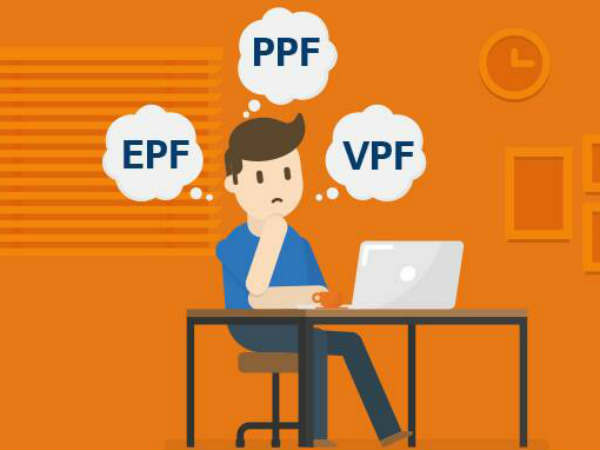PPF, EPF, or VPF: Which is a better saving option?
Retirement planning is always a topic of discussion among the young and middle-aged generations. Nowadays, no one wants to work till retirement and hence are always eager to look at savings options to plan for their retirement accordingly. And retirement planning is not an easy task and requires a lot of thought as financial expectations can be challenging to predict. Because after retirement, you may not have enough money to meet your basic needs. It means you need to finalize an appropriate savings scheme that will help you enjoy retirement without any trouble.
Investment Options
In this age, there is no shortage of investment avenues – Cash, Shares, National Pension Scheme (NPS), Post office savings, LIC policies, ULIPs, Public Provident Fund (PPF), Employee Insurance (EPF), Voluntary provident fund (VPF) are some of the most popular schemes that facilitate long term investment goals. The big question now is: which to choose among these? You cannot invest your hard-earned income in everything. From our past experiences with our parents, it makes sense to invest in various investments and then direct the money to compensation applications, such as EPF, PPF, and VPF.
Now, your mind must be raising the big question here again: which is the best or the better saving option amongst the others? Furthermore, what is one of the best investment schemes that offer maximum return? To better understand this, we will compare the top three schemes and look at the major differences between EPF and PPF vs VPF.
- Public Provident Fund (PPF): PPF is a government-provided savings option for individuals to start long-term savings. It is specifically targeted at people working in the informal or unorganized sector and the unemployed and self-employed, who can invest in PPF. Similarly, taxpayers can claim a tax deduction of up to Rs 1,50,000 per year by investing in PPF. A minimum investment of Rs 500 must be made in a financial year to continue operating the PPF account. No more than 1,50,000 rupees can be invested in a year. The rate of interest is currently fixed at 7.1 percent.
- Employee Provident Fund (EPF): EPF is also a government-mandated savings scheme but is a compulsory worker deduction. It is a fund in which both the employee and the employer provide monthly 10% of the employee’s basic salary. Previously, this proportion was 12 percent in private companies. In addition, the employer and the employee contribute to the Employee Support Fund (EPFO) each month. The employee may withdraw in full or in parts upon retirement, termination, or the event of any crisis such as the COVID-19 pandemic. Likewise, this amount can be transferred from one organization to another if the employee changes or quits their job. The EPF interest rate 2021-22 is 8.5 percentage annually, which is determined by the government regularly and could vary in the future.
- Voluntary Provident Fund (VPF): VPF is a voluntary fund contribution to the provident fund account by the employee. This is beyond the 12% contribution by an employee towards his EPF.VPS is available only for those who are salaried and receive monthly payments through a particular salary account. While the VPF interest rate stands at 8.5% currently, the government of India shall determine the rates periodically.
Major Differences between PPF, EPF and VPF
To answer this question, let us first understand the differences between the above saving schemes because these parameters shall help determine the best scheme.
- Eligibility: Only salaried professionals can open EPF and VPF. On the other hand, anyone has the right to open a PPF account. The majority of banks and all post offices offer PPF services. You can also open a PPF account online by visiting the bank’s official website.
- Contribution: For EPF, the minimum contribution of employer and employee is 12 percent of salary + employee dearness allowance. Through VPF, a user can deposit any amount up to 100% of his salary + that dearness allowance. For PPF, entry is optional, and investment is acceptable up to Rs. 1.5 lakhs per year.
- Returns: As of today, the PPF interest rate fixed by the government is 8%. As the interest rate of PPF is linked to the 10-year yield on government bonds, interest rates fluctuate regularly. EPF and VPF rates are similar and now provide 8.55%.
- Investment tenure: The lock-in period of PPF is 15 years, and an individual can choose to renew in blocks of 5-years. For EPF and VPF, the account is valid until you leave or retire from the organization. If you switch your company, you can transfer your account to another organization or company.
- Tax Benefits: The returns earned through PPF investments are exempted from tax. Even the returns generated through EPF and VPF are tax-free, but this is applicable if the employer has worked for the employer for at least five years.
- Loan: The biggest benefit of these investment schemes is the facility to apply for a loan against these accounts. With PPF, one may get a loan on their investments and apply for the first loan after three years of investing until the second year to get up to 25% of the balance.
- Similarly, you may apply for the second loan before the end of your 6th financial year. But the second loan can only be taken out after the first loan is completely settled. On the other hand, the EPF and VPF allow you to apply for a loan up to 100% of your accumulated balance.
Having read about the difference between EPF and PPF and vpf, it is time for you to make the right choice. To answer the question of choosing the best investment option, EPF or VPF is the perfect choice for you if you are a salaried employee. But if you work independently or are self-employed or running your own business, then PPF is the best option for its simplicity and benefits.





























